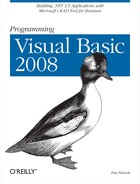A note on the digital index
A link in an index entry is displayed as the section title in which that entry appears. Because some sections have multiple index markers, it is not unusual for an entry to have several links to the same section. Clicking on any link will take you directly to the place in the text in which the marker appears.
Symbols
- #Const directive, Directives and Assemblies
- #If directive, Directives and Assemblies
- #Region directive, Directives and Assemblies
- .config files, A Short History of Settings
- .dll files, Assemblies and Manifests
- .hhc files, Assistance Platform
- .hhk files, Designing HTML Help
- .hhp files, Designing HTML Help
- .msi files, Windows Installer Deployment
- .NET Framework, Who Is Reading This Book?, Introducing .NET, Before .NET, Back to Introducing .NET, Back to Introducing .NET, The Parts of the .NET Framework, The Common Language Specification, The Common Type System, .NET Class Libraries, Assemblies and Manifests, Assemblies and Manifests, Versioning, From Source Code to EXE, What About Visual Studio and Visual Basic?, Visual Studio 2008, Visual Studio 2008, The History of the Visual Basic Revolution, The Basics of Logic and Data, Advanced Declaration, .NET Assemblies, Visual Basic Data Types, What Is ADO.NET?, Printing in .NET, Printing in “Raw” Mode, ASP.NET Features, Windows Communication Foundation
- (see also ADO.NET), What Is ADO.NET?
- assemblies, .NET Assemblies
- assemblies and manifests, Assemblies and Manifests
- before .NET, Before .NET
- benefits of, Back to Introducing .NET
- class libraries, .NET Class Libraries
- CLR (Common Language Runtime), The Parts of the .NET Framework
- CLS (Common Language Specification), The Common Language Specification
- CTS (Common Type System), The Common Type System, The Basics of Logic and Data
- data types and Visual Basic equivalents, Visual Basic Data Types
- history of, The History of the Visual Basic Revolution
- implementation of Visual Basic data types, Advanced Declaration
- lack of raw printer support, Printing in “Raw” Mode
- metadata and attributes, Assemblies and Manifests
- objects, Back to Introducing .NET
- printing system, Printing in .NET
- Remoting, Windows Communication Foundation
- support of ASP.NET, ASP.NET Features
- versioning, Versioning
- versions supported by Visual Studio 2008, Visual Studio 2008
- Visual Basic development process, From Source Code to EXE
- Visual Studio 2008, Visual Studio 2008
- Visual Studio and Visual Basic, What About Visual Studio and Visual Basic?
- .rdlc files, Adding a Report Design Surface
- .resources files, Resource File Generation
- .resx files, Resource Files
- .svc files, Windows Communication Foundation
- .vb files, From Source Code to EXE
- 3D graphics, Windows Presentation Foundation
- <% . . . %> bracket pair for ASP.NET-specific commands and code, Trying Out ASP.NET
- <%= and %> symbols, Embedded XML Expressions, LINQ to XML
- bracketing LINQ-specific code, LINQ to XML
- embedded XML expressions, Embedded XML Expressions
- <%@, ASP.NET page directives, Trying Out ASP.NET
- <?xml . . . ?>, XML document declaration, The Basic XML Classes, Basically
- <asp:xxx> tag, Trying Out ASP.NET
- <xsl:template> elements, XML Schemas
- “DLL hell”, Back to Introducing .NET
- “Hello, World!” code example, The Common Language Specification, Summary
- “raw” mode, communication with printers, Printing in “Raw” Mode
- “VCR” control, Using a Data Source
..................Content has been hidden....................
You can't read the all page of ebook, please click here login for view all page.
